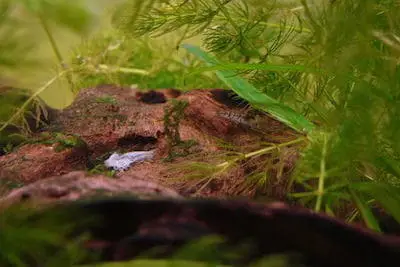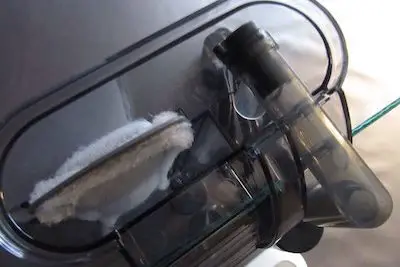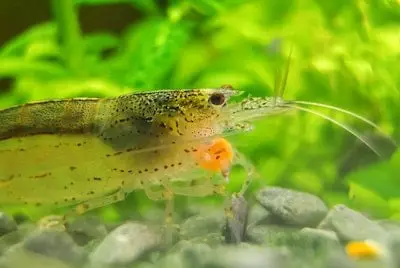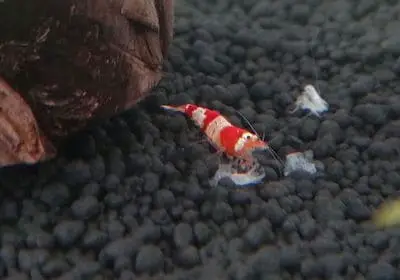What Do Shrimp Need in a Tank? (Answered!)
Contrary to what some people might think, freshwater shrimp have pretty minimal tank requirements, and they’re generally easy to care for.
However, there are certain tank necessities you’ll need to obtain to provide your shrimp with the best home.
So exactly what do shrimp need in a tank? In this guide, I’ll answer this question in detail and highlight some key differences between shrimp breeding tanks and those kept for hobbies.
Contents
Shrimp Tank Necessities
Keeping shrimp has become increasingly popular in recent years, and not just because it’s so easy to set up a freshwater shrimp tank.
There are various types of freshwater shrimp to choose from, from ghost shrimp to red cherry shrimp.
Although some believe that shrimp are too delicate and high-maintenance to take care of, as long as you take the right steps to set up a proper tank, you’ve got nothing to worry about.
Here are some of the basic tank necessities.
Aquarium/Tank
The first step you should take to provide your shrimp with the best artificial habitat is a proper-sized tank.
Unlike most freshwater fish species, which require large tanks, shrimp can be kept in small to medium-sized aquariums. In fact, your aquarium only needs to accommodate 10 gallons of water.
If you plan to have one or two shrimp, then you don’t really need a big tank, as they can survive in nano tanks that you can place anywhere in your home. This especially applies to Dwarf Shrimp.
However, if you plan to set up a breeding tank, it’s a good idea to acquire a tank containing between 20 and 30 gallons of water.
If you buy a tank that’s too small or too big, it could cause drastic changes in water parameters, which shrimp are especially sensitive to. This could cause stress and even lead to premature death.
Lighting
Adding adequate lighting is not only important for the shrimp to thrive, but for your aquarium plants as well.
Keep in mind that these crustaceans don’t require intense lighting, and if they are exposed to strong lighting conditions, it might harm their health. That’s why it’s important to provide them with enough places to hide.
If your shrimp tank doesn’t have any aquatic plants for your shrimp to hide in, you can use a regular LED aquarium lamp for your shrimp. In addition, it’s vital that your tank lamp doesn’t increase the water temperature.
If you do have plants in your tank, then the type of lighting should depend on the species of aquatic plants.
Apart from LED lights, you can also use fluorescent lamps and metal halides for your shrimp tank. Keep in mind that the lighting factor won’t influence the likelihood of your shrimp breeding.
For more information on the need for lighting in shrimp tanks, click here.
Filter
Choosing the proper filter for your shrimp tank is also an important step you need to take.
If you aren’t familiar with aquarium filters, you can always ask your local pet store to help you select an appropriate filter for your shrimp.
This step can be tricky because shrimp produce waste, so your filtration system needs to be effective.
Not only is your tank filter supposed to keep the tank clean, but it should also help cultivate beneficial bacteria necessary for the well-being of your shrimp.
Most importantly, the right aquarium filter should be 100% safe.
You can use various types of filters for your shrimp tank, such as sponge filters, internal filters, ‘hang on back’ filters, and canister filters.
Sponge filters are best for smaller shrimp tanks, and canister filters are ideal for larger tanks containing up to 20 gallons of water.
It goes without saying that buying a high-quality filter will keep your shrimp healthy, thus increasing the possibility of them breeding.
Similar to filters, you might also consider a bubbler for your shrimp. These improve water circulation and water flow in the tank, which then improves oxygenation in the tank.
However, bubblers may not always be needed in shrimp tanks – click here to learn more.
Heater and Thermometer
Shrimp can live in room-temperature water just fine, but acquiring a heater for your tank is always a good idea.
What’s more, this can be especially vital if your room temperature is prone to sudden changes, which is another thing shrimp don’t react well to.
Keep in mind that your tank heater should have the capacity to heat your entire tank. In other words, make sure the tank isn’t too big for the heater.
For example, if your tank has 30 gallons of water, it’s a good idea to purchase two heaters and install them on opposite sides of the tank.
The ideal water temperature for most shrimp is between 70 to 79 degrees Fahrenheit, with the only exception being Neocaridina Shrimp, which prefer cooler temperatures.
If you want a device that will maintain the same water temperature at all times, a thermostat heater is a perfect solution. What’s great is that they warm up the water only when they detect a sudden drop in water temperature.
You’ll also need a thermometer for your shrimp tank, as it’s the best way to estimate the water temperature.
Gravel or Substrate
Your shrimp tank should have enough substrate so that the entire bottom is covered, and at least 1 inch of the tank’s height should be filled with substrate.
This is especially important if you choose to have aquatic plants.
For most species of shrimp, the best substrate choice is sand or gravel. However, if you want your aquatic plants to root more easily, then I suggest going with gravel.
It’s also important to make a distinction between an inert or active substrate, which is related to whether your shrimp prefer soft or hard water.
For example, the Red Bee Shrimp prefer soft water, whereas Neocaridina Shrimp prefer harder water.
Plants, Driftwood, and/or Rocks
The aquarium’s decorations are one of the most important factors influencing whether or not your shrimp will breed.
For a regular shrimp tank, adding plants and driftwood is always a plus. This is important as your shrimp need places to hide. If they’re always in the open, they will feel vulnerable and stressed, especially when molting.
The best type of décor for your shrimp tank is live plants. Not only do they give your shrimp that all-important place to hide, but they also come with numerous health benefits.
Shrimp also like to hide in driftwood, ceramic tubes, coconut caves, and cholla wood. Rocks and stones can be great additions to your shrimp’s environment.
However, if you want to set up a breeding tank, it’s best not to have too many decorations. The best plant you can place in a breeding tank is moss.
Since you want to be able to actually see the shrimp, avoid densely planted tanks. If you do have some decoration, make sure that it can be easily removed.
Another thing to keep in mind if you want to have a breeding tank, you shouldn’t place any fish in there. Many fish are predators of shrimp, and in general, shrimp prefer to be surrounded by their own kind.
Water Conditioning
Keeping your tank water clean and at the right parameters is one of the most essential aspects of keeping your shrimp healthy and happy.
Water conditioning is based on the type of water you use. The main types include tap water, distilled water, and RO water.
While your filter is supposed to maintain the tank’s hygiene, you can also use hardening salts to demineralize water treatment. Not only does hardening salt help maintain beneficial bacteria in the tank, but it also helps aquatic plants to thrive.
Since high levels of ammonia and nitrite can be pretty harmful to your shrimp, you should cycle the tank before acclimating your shrimp when you first set it up, then be sure to change your tank’s water at least once a week.
Another thing to look out for is making sure, if any of your shrimp die, that you remove them from the tank. If you leave the dead shrimp in there, it can lead to ammonia spike in your water levels.
Food
All types of shrimp require a natural balanced diet to stay healthy. A good diet will also make them happier, increasing the possibility of breeding.
If your aquarium has plants, the shrimp will usually eat the biofilm on moss, leaves, and any other surface.
On the other hand, if your shrimp live in a tank with no plants, it’s important to feed them daily.
To be more specific, you can feed your shrimp with vegetable pellets, granules, and even vegetables like peas, spinach, zucchini, carrots, etc.
To ensure that the leftovers don’t end up mixed with the gravel, place all the food on a transparent tray or a feeding dish. This will make the tank easier to clean.
In Summary
It doesn’t matter whether you plan to keep shrimp for breeding purposes or just because you like them. If you set up a healthy and clean environment, they are sure to thrive in their tank.
Even though they can be sensitive to sudden changes in diet, temperature, or environment, it’s very simple to provide them with what they actually need.






